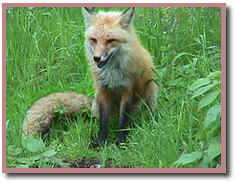
Red Fox
Eleven furbearer species are managed and trapped in Newfoundland and Labrador, including beaver, fox, lynx, coyote, mink, muskrat, otter, red squirrel, weasel, marten, and wolf.
Approximately 16,000 people in the province trap and snare furbearers as a means of supplementing income.
Furbearer Populations
Furbearer populations fluctuate from year to year and are influenced by factors such as predator/prey relationships, food supply and disease. Trapping pressure can also influence population growth or decline. For example, if the price of a species on the fur market is high trappers tend to put more effort into trapping that species.
Lynx depend mainly on snowshoe hare as a food source and as a result, tend to follow the population cycles of snowshoe hare. The lynx cycle is slightly out of sync with the hare cycle. For example, lynx numbers tend to peak one to two years after hare numbers peak.
Since the mid 1970s, muskrat populations have been strongly suppressed by mink. Mink predation virtually eliminated muskrat from many parts of Newfoundland and it is only in recent years that muskrat have been making a recovery in many areas.
Coyote is a new species to the Island as a result of a natural introduction believed to have occurred in the mid 1980s, when coyotes came ashore on pack ice in the Gulf of St. Lawrence.
The Newfoundland Marten is a threatened species on the Island and has been protected since 1934. In Labrador, however, the American marten population is healthy, with between 508 to 1,390 martens harvested annually.
Wolf occur only in Labrador, with fewer than 50 harvested annually.
Furbearer Management
There are 13 furbearer management zones throughout Newfoundland and Labrador. Within these zones, harvest activities for each species occurs during optimum periods for fur quality, which is generally during the fall and winter period. However, furbearer seasons may vary for each different species.
The Wildlife Division monitors the status of the provinces furbearer populations through trend data such as trapper effort, trapper success, cumulative index, and relative abundance obtained from trapping licence returns.
Anecdotal information from area Conservation Officers, trappers, and the general public also serves as an indicator of how furbearer populations are doing.
The Wildlife Division develops an annual furbearer management plan for Newfoundland and Labrador based on furbearer harvest trends, input from Conservation Officers and other staff of the Department of Natural Resources, input from non-governmental organizations and from the general public.
The Furbearer Management Plan covers issues related to trapping seasons, fur zone boundaries, and other specific recommendations made by staff and the public. The Management Plan is presented at the Provincial Small Game and Furbearer Management meeting with headquarters and regional staff. Following ministerial approval of the plan, feedback is provided to regional representatives on the resolution of all issues contained in the plan.
Information regarding trapping is then made available to the public through the Annual Hunting and Trapping Guide.
Adobe® Acrobat® Reader software can be used for viewing PDF documents. Download Acrobat® Reader for free.
